When you think of Poodles, images of elegant show dogs or perhaps bubbly companions come to mind. But have you ever wondered how these beloved pups differ across the globe? From grooming preferences to temperament variations, Poodles around the world exhibit intriguing distinctions that reflect their regional roots. As you explore the nuances in Poodle types and traits, you'll uncover a fascinating tapestry of canine diversity waiting to be unraveled.
Key Takeaways
- Poodle appearances vary globally due to diverse grooming practices and breeding standards.
- Temperamental traits differ across regions based on breeding purposes and environmental factors.
- Poodle popularity is influenced by cultural grooming preferences and breed characteristics.
- Rescue efforts worldwide aim to provide abandoned poodles with care and new loving homes.
Poodle Varieties by Region
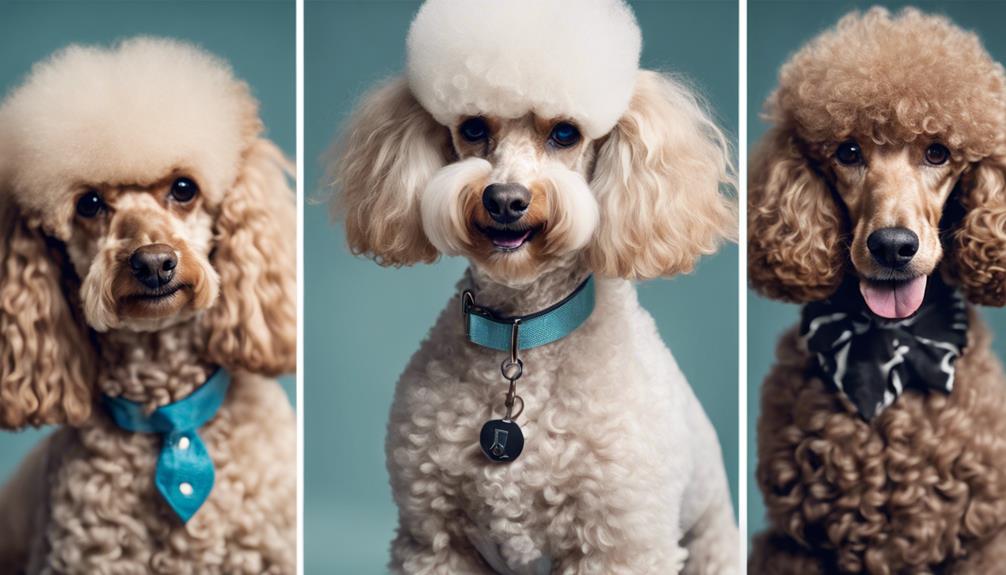
When examining poodle varieties by region, it becomes evident that grooming practices and breeding standards play a significant role in shaping the distinct physical characteristics of these dogs. Poodle breeds exhibit variations in sizes and features influenced by regional grooming practices. For instance, in Korea and Japan, poodles are often groomed in a teddy bear style, giving them a unique appearance with shorter snouts and legs compared to poodles from other regions. These regional grooming practices contribute to the overall look and size of the poodles. Additionally, breeding practices in different regions further impact poodle sizes and characteristics, such as variations in leg length. Understanding these regional differences in grooming styles and breeding practices is crucial in comprehending the diverse appearances of poodles worldwide. By recognizing the influence of regional factors on poodle breeds, one can appreciate the nuances in their physical attributes and better cater to their specific needs.
Physical Characteristics Across Regions

Regional grooming practices and breeding standards significantly influence the physical characteristics of poodles, shaping distinct variations in sizes and features across different regions. In Korea, poodles may exhibit a teddy bear appearance due to unique grooming styles, with some having shorter snouts and legs compared to poodles from other regions. Despite regional variations, the international breed standard emphasizes a long, straight, and fine muzzle. Notably, shorter legs in poodles from certain regions could indicate genetic mutations affecting spine health. Achieving the teddy bear look in poodles involves growing out face fur, a grooming trend seen in various regions.
- Poodles from Korea may exhibit a teddy bear appearance due to unique grooming styles popular in the region.
- Some Korean poodles may have shorter snouts and legs compared to poodles from other regions.
- Achieving the teddy bear look in poodles involves growing out face fur, a grooming trend seen in various regions.
Temperamental Variances in Poodles
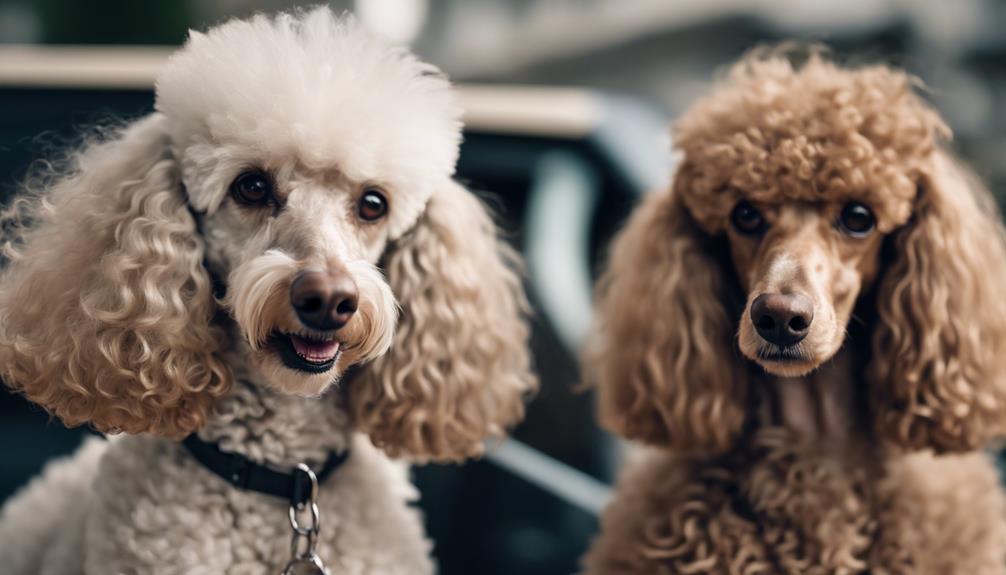
Temperamental variations in Poodles around the world are influenced by diverse breeding practices and environmental factors. Regional differences play a significant role in shaping the temperament of Poodles. Cultural attitudes towards dog training and socialization also contribute to these variances. Poodles bred for specific purposes in various countries may exhibit distinct temperamental traits based on their historical roles. Understanding these regional differences is crucial for tailoring training and socialization approaches to meet the specific needs of Poodles.
| Temperamental Aspect | Regional Variances |
|---|---|
| Sociability | Poodles in some regions may be more outgoing and friendly, while in others, they might be reserved. |
| Trainability | Breeding practices and training methods can impact how easily Poodles in different regions respond to commands. |
| Energy Levels | Environmental factors such as climate and lifestyle can influence the activity levels of Poodles across the globe. |
| Aggression Levels | Cultural attitudes towards aggression and dominance may affect the aggression levels seen in Poodles in various regions. |
| Anxiety Levels | Environmental stressors and breeding practices can contribute to varying levels of anxiety in Poodles worldwide. |
Poodle Breeding Practices Worldwide
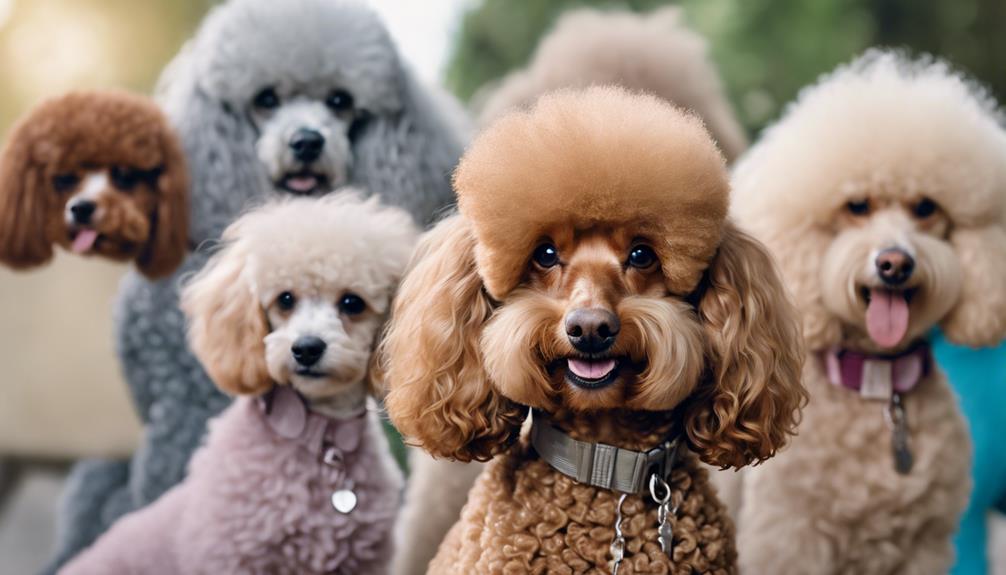
When examining Poodle breeding practices worldwide, it is crucial to consider the established breeding standards, genetic diversity maintained in breeding programs, and the paramount importance of health considerations throughout the breeding process. Genetic diversity plays a vital role in ensuring the overall health and well-being of Poodles, while adherence to breeding standards helps maintain the desired breed characteristics. Prioritizing health considerations during breeding can help mitigate hereditary issues and promote the longevity of Poodles across different regions globally.
Breeding Standards Worldwide
Different countries worldwide adhere to distinct breeding standards for Poodles, focusing on specific physical traits to maintain the breed's integrity and health. When it comes to breeding standards for Poodles, several key points stand out globally:
- Emphasis on muzzle length and body proportions in breeding practices.
- Unique teddy bear grooming style in Korea and Japan, which may differ from international standards.
- Deviations from breed standards can lead to health issues like spine and leg length mutations.
Adhering to international breeding standards is vital for safeguarding the health and wellness of Poodles in various regions. It's essential to exercise caution when selecting a Poodle from Korea, as differences in breeder quality and practices can impact the overall well-being of the breed.
Genetic Diversity in Breeding
Breeding practices for Poodles worldwide exhibit diverse genetic variations, impacting the breed's health and physical characteristics. Regional breeding practices, like those in Korea and Japan favoring unique grooming styles such as the teddy bear cut, can influence traits like snout and leg length. Genetic mutations affecting leg length in Poodles may arise from these practices, potentially leading to spinal issues. Adherence to breeding standards is crucial to mitigate such risks. Variations in breeding practices globally underscore the importance of selecting reputable breeders who prioritize the health and well-being of the Poodle breed. While grooming preferences may differ, maintaining genetic diversity within established standards is vital for preserving the overall health and appearance of Poodles.
Health Considerations in Breeding
The impact of genetic mutations on Poodle health underscores the critical importance of adhering to established breeding standards worldwide. When considering health considerations in breeding, it is imperative to focus on breeding practices that prioritize the well-being of the poodles. Genetic mutations affecting leg length can result in spinal problems, emphasizing the significance of following breed standards to avoid such issues. Here are three key points to consider:
- Deviation from standard breeding practices can lead to medical conditions in poodles.
- Poodles with shorter legs may suffer from spine and vertebrae issues due to genetic variations.
- Adherence to the international poodle breed standard is crucial for the overall health and quality of the breed.
Regional Health Concerns in Poodles

Regional variations in grooming practices and potential genetic mutations can impact the health of poodles, particularly in countries like Korea where shorter legs and distinctive appearances are prevalent. Korean poodles, with their teddy bear appearance achieved through specific grooming styles, may experience health issues related to spine health due to deviations from the international breed standard. It is crucial to consider responsible breeding practices to prevent medical concerns in poodles with shorter legs in Korea. Understanding the regional grooming trends and breed standards becomes vital in selecting a healthy poodle, irrespective of its origin. By being aware of these factors, you can ensure that the poodle you choose is less likely to face health challenges associated with breed standard deviations. Remember, informed decisions regarding grooming practices and breeding are key to promoting the overall well-being of poodles in different regions.
Poodle Grooming Trends by Region
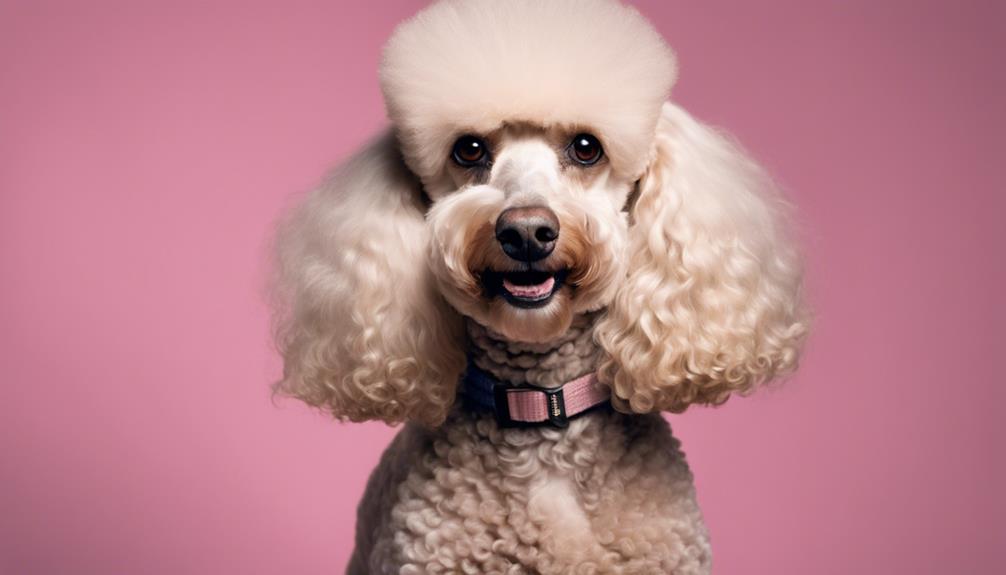
In different regions, Poodle grooming techniques showcase unique styles that cater to specific preferences. These grooming trends often emphasize popular styles like the teddy bear look, which involves creating a softer and rounder appearance. Understanding these regional grooming practices provides insights into the diverse aesthetic choices embraced by Poodle owners worldwide.
Regional Grooming Techniques
Amid diverse poodle grooming styles worldwide, distinct regional techniques shape the iconic teddy bear look sported by these beloved canine companions. In Korea and Japan, poodles often undergo grooming to achieve a teddy bear style, characterized by rounded faces and fluffy bodies. The grooming techniques used in these regions may differ, resulting in variations such as shorter snouts and legs seen in Korean poodles compared to those from other areas. Emphasizing a cute and cuddly appearance, grooming styles in Korea and Japan play a crucial role in shaping the physical characteristics of poodles in these regions.
- Korean poodles may have shorter snouts and legs.
- Grooming techniques in Korea and Japan aim for a teddy bear look.
- Emphasis is placed on achieving a cute and cuddly appearance.
Popular Grooming Styles
Distinct grooming styles by region significantly influence the popular trends in Poodle grooming, with a particular emphasis on achieving the iconic teddy bear cut. In Korea and Japan, this style is favored, focusing on a rounded face and a fluffy appearance. Regional grooming preferences in Korea may result in Poodles with shorter snouts and legs compared to international standards. To achieve specific looks, grooming practices in these regions might deviate from traditional breed standards. The teddy bear cut involves growing out facial fur to create a softer, rounded aesthetic. While grooming trends vary across regions, it is crucial to adhere to breed standards to ensure the health and well-being of Poodles.
Working Poodles: Regional Utilization Differences

Working Poodles worldwide exhibit distinct regional differences in their utilization for various tasks, showcasing their adaptability and versatility as intelligent working dogs. In France, Poodles were highly valued as water retrievers and skilled hunting dogs, demonstrating their aptitude for retrieving game both on land and in water. In Germany, these intelligent dogs were utilized for waterfowling, retrieving game, and even locating lost arrows, highlighting their diverse skill set and keen sense of smell. Poodles in the UK were renowned for their exceptional intelligence and trainability, making them popular choices for circus performances and obedience training due to their quick learning abilities and eagerness to please. Across the pond in the US, Poodles have excelled in service roles such as therapy and assistance dogs, leveraging their high intelligence and sociable nature to provide valuable support to those in need. The regional differences in the utilization of working Poodles underscore their remarkable adaptability and effectiveness in various tasks.
Poodle Training Techniques Across the Globe
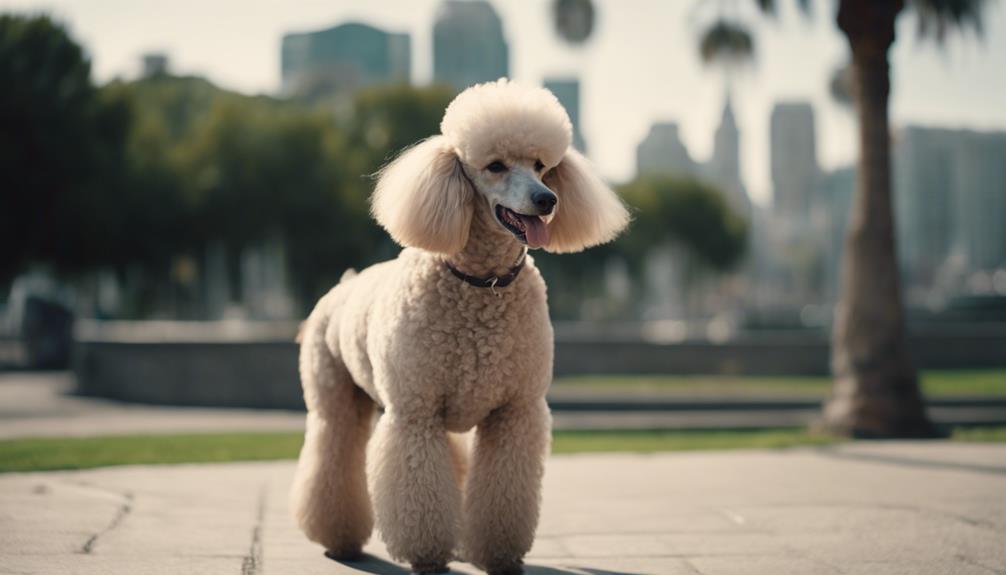
When considering Poodle training techniques across the globe, it becomes evident that a variety of approaches are utilized to enhance these intelligent and versatile dogs' skills and behavior. Positive reinforcement is a common method in North America and Europe, emphasizing rewarding desired behaviors to encourage their repetition. In contrast, Asian countries like Japan and Korea may focus on grooming and behavior training simultaneously, recognizing the importance of both aspects in a Poodle's development. In Europe, obedience and agility training are often incorporated to enhance the Poodle's intelligence and sociability, promoting a well-rounded skill set.
| Training Techniques | Region |
|---|---|
| Positive Reinforcement | North America, Europe |
| Grooming and Behavior Training | Japan, Korea |
| Clicker Training | Australia |
Australia stands out for its use of clicker training methods, effectively reinforcing desired behaviors in Poodles. While different regions may have specific training trends, the universal keys to successful Poodle training worldwide remain consistency, patience, and tailored approaches.
Poodle Shows and Competitions Worldwide
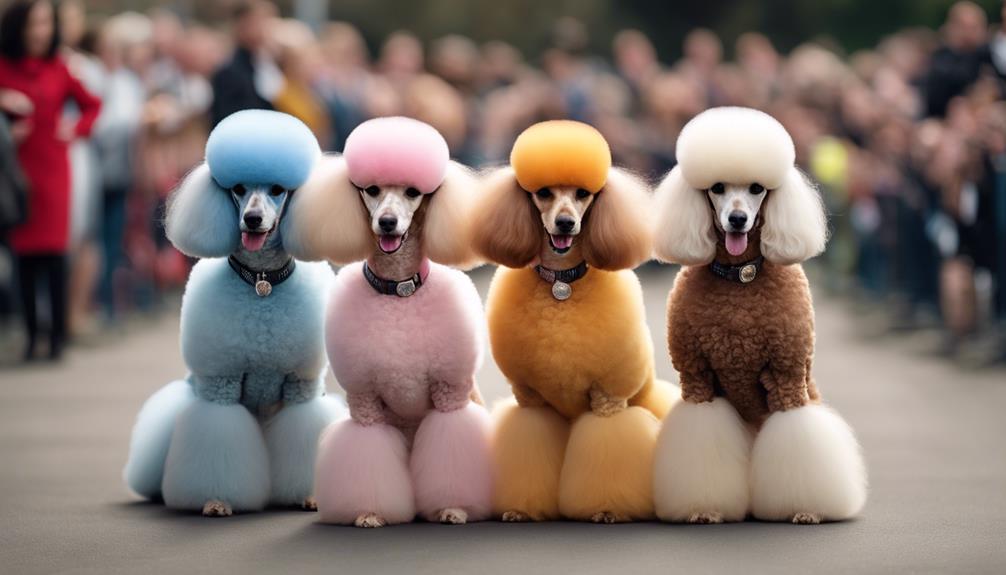
Poodle shows and competitions around the world serve as platforms for showcasing the breed's elegance, skills, and athleticism on a global stage. These events bring together Poodle enthusiasts from various regions to celebrate the breed's unique qualities. Here are some key highlights:
- World Dog Show: This prestigious event features Poodles from around the globe, allowing breeders and owners to exhibit their top-quality dogs and compete at an international level.
- Poodle Club of America: Known for hosting the PCA National Specialty Show in the US, this club plays a vital role in organizing competitions that emphasize the breed standards and promote excellence in Poodle breeding.
- AKC Agility Invitational: Agility competitions like this showcase the Poodle's intelligence and athleticism, demonstrating their ability to navigate complex courses with precision and speed.
These competitions not only celebrate the beauty and talent of Poodles but also contribute to the advancement and recognition of the breed on a worldwide scale.
Poodle Ownership Trends in Different Regions

The global landscape of pet ownership trends reveals a notable surge in Poodle ownership, particularly evident in regions like Korea. This rise in ownership can be attributed to the increasing trend of pet ownership in the country. Japan and Korea are known for their unique grooming styles for Poodles, showcasing a cultural influence on pet care practices. However, it's essential to note that different regions may have varying breeder quality standards for Poodles. In response to irresponsible breeding practices, the Korean government is taking steps to address these issues and promote responsible ownership.
Understanding the regional differences in Poodle ownership trends, grooming styles, and breeder quality standards is crucial for ensuring responsible pet acquisition. By staying informed about these variations, prospective Poodle owners can make informed decisions about where to acquire their pets and how to provide them with the best care possible. Monitoring these trends can also help identify areas where improvements are needed in standards and regulations for Poodle breeding and ownership. Additionally, being aware of these regional differences allows owners to anticipate and address potential challenges, such as adapting to local grooming practices or dietary preferences specific to their area. It also highlights the importance of educating oneself about common Poodle health problems, including hip dysplasia, progressive retinal atrophy, and Addison’s disease, which can vary in prevalence depending on breeding practices and genetic lines. By prioritizing both breed-specific health considerations and regional factors, Poodle enthusiasts can contribute to raising the standard of care for these intelligent and beloved pets.
Poodle Adaptation to Climate Variations

Adapting to diverse climate variations, poodles exhibit distinct grooming needs reflective of their environmental conditions. Poodles in colder climates may develop thicker coats to withstand harsh weather conditions, providing them with insulation against the cold. Conversely, poodles in warmer regions tend to sport lighter trims to prevent overheating, allowing for better temperature regulation. Regional variations in grooming styles can offer insights into the climate poodles inhabit, showcasing how they have adapted to their surroundings. Additionally, poodles with unique coat patterns often require tailored grooming approaches to maintain their distinct appearances while ensuring practicality for their environment. These specialized grooming techniques not only highlight the individuality of each poodle but also support their health and comfort in varying climates. By observing these adaptations, one can gain a deeper appreciation for the relationship between a poodle’s grooming needs and the ecological demands of their habitat.
- Poodles in humid areas may require more frequent grooming to prevent matting and skin issues caused by the moisture in the air.
- Poodles residing in areas with extreme temperatures may exhibit different behaviors to cope with the climate, such as seeking shade more frequently or engaging in activities that help regulate their body temperature.
- Understanding these poodle adaptation strategies can aid in providing optimal care for these beloved companions in various climate conditions.
Poodle Popularity Rankings by Country

Ponder the intriguing trends in Poodle popularity across various countries. Explore the factors that influence the breed's appeal in different regions. Uncover how cultural preferences, historical significance, and breed standards shape the Poodle's ranking in different parts of the world.
Country Poodle Preferences
Country preferences for Poodles vary widely, reflecting diverse cultural attitudes towards this beloved breed. Japanese enthusiasts hold a special fondness for Poodles, often referring to them as 'French Poodles' and adorning them with intricate grooming styles. In France, Poodles enjoy a deep-rooted connection, being considered a national breed with a historical significance. South Korea has witnessed a surge in Poodle ownership, indicating a growing interest in purebred dogs in the region. These varying levels of adoration and appreciation for Poodles across different countries highlight the breed's universal appeal and adaptability. In the United States, Poodles are celebrated not only for their intelligence and trainability but also as a versatile breed that suits families, show rings, and various dog sports. The moyen poodle breed overview often highlights their medium size, placing them perfectly between the standard and miniature varieties, making them an ideal choice for many households. This adaptability, along with their hypoallergenic coats and cheerful temperament, ensures that Poodles remain a cherished breed across the globe.
Factors Influencing Popularity
Poodles' popularity rankings vary across countries, reflecting distinct cultural preferences and trends in canine companionship. When considering factors influencing popularity, it's evident that breed standards and grooming styles play a significant role. Below is a table showcasing Poodle popularity rankings in select countries:
| Country | Popularity Ranking | Influencing Factors |
|---|---|---|
| United States | Top 10 | Consistent AKC recognition |
| Germany | Significant | Historical origin, breed standards |
| Japan | Strong following | Unique grooming styles, adaptability |
| UK | Steady | Intelligence, versatility |
Understanding these influences provides insight into why Poodles maintain their popularity worldwide. Their hypoallergenic coat, intelligence, and adaptability continue to attract dog lovers globally.
Poodle Rescue Efforts in Various Regions

Poodle rescue efforts in various regions worldwide are crucial for the rehoming and rehabilitation of abandoned or surrendered poodles in need of care and love. These efforts are orchestrated by dedicated organizations and individuals who work tirelessly to ensure the well-being of these beloved dogs. Here are some key points regarding poodle rescue efforts globally:
- The Poodle Club of America Rescue Foundation in the US plays a significant role in rescuing and rehoming poodles in need within the country.
- The UK Poodle Network focuses on rescuing and finding new homes for poodles in the United Kingdom, contributing to the welfare of these dogs in the region.
- Organizations like Korea Animal Rights Advocates (KARA) in Asia work diligently to rescue and rehabilitate poodles, highlighting the international scope of poodle rescue efforts.
Through collaborative initiatives and the dedication of these rescue groups, abandoned poodles find hope, care, and the opportunity for a new beginning in loving homes across different regions.
Frequently Asked Questions
What Region Are Poodles From?
Poodles hail from various regions like Germany, France, and beyond. Breeders across the globe have honed their distinctive traits. Their origins are intertwined with waterfowling history. Poodles' intelligence, elegance, and versatility make them beloved companions worldwide. Renowned for their curly coats and athletic prowess, poodles have been a symbol of sophistication and charm for centuries. The history of poodle breeds reflects their evolution from hardworking water retrievers to fashionable pets and skilled performers in various arenas. Today, they thrive not only as show dogs but also as loyal family members and service companions, proving their enduring adaptability.
What Did Some Poodles Do in Europe?
In Europe, some Poodles excelled in water retrievals, showcased their talents in circuses, and were depicted in 17th-century artworks. They were popular for their intelligence and agility, reflecting a rich history of diverse activities. In addition to their versatile roles, Poodles also gained admiration for their distinct coat styles and trainability, which set them apart from other breeds. The unique traits of phantom Poodles, such as their striking two-toned markings and lively personalities, further contributed to their allure and popularity. These characteristics not only highlighted their aesthetic appeal but also underscored their rich diversity within the breed.
What Is the Difference Between a Poodle and a French Poodle?
When differentiating a Poodle from a French Poodle, consider grooming needs where both require regular care. In terms of temperament, Poodles are known for intelligence, while size varies. Recognize nuances to appreciate these distinct breeds accurately.
What Are the Different Types of Poodles?
You've got three main types of Poodles: the Standard, Miniature, and Toy. They come in various sizes, making them a bit like the Goldilocks of the dog world! From towering Standards to pint-sized Toys, Poodles have it all. Each type has its unique charm and suits different lifestyles, ensuring there’s a perfect Poodle for everyone. When considering toy vs miniature vs standard poodles, it’s important to think about your space, activity level, and personal preferences. Regardless of size, all Poodles share their signature intelligence, curly coats, and lovable personalities.
Conclusion
You have explored the diverse world of Poodles, discovering their unique variations and similarities across regions. One fascinating statistic to note is that the United States ranks as the top country for Poodle ownership, with over 800,000 registered Poodles nationwide. This highlights the breed's enduring popularity and appeal to dog lovers around the world. Keep in mind the importance of breed standards and responsible ownership to ensure the well-being of these intelligent and adaptable dogs.
